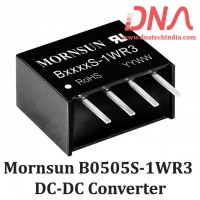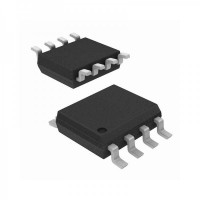Resistor Colour Code |
||
|
We saw in the previous tutorial that there are many different types of Resistors available and that they can be used in both electrical and electronic circuits to control the flow of current or voltage in many different ways. But in order to do this the actual resistor needs to have some form of "resistive" or "resistance" value. Resistors are available in a range of different resistance values from fractions of an Ohm ( Ω ) to millions of Ohms. Obviously, it would be impractical to have available resistors of every possible value for example, 1Ω, 2Ω, 3Ω, 4Ω etc, because literally hundreds of thousands, if not millions of different resistors would need to exist to cover all the possible values. Instead, resistors are manufactured in what are called "preferred values" with their resistance value printed onto their body in coloured ink. |
||
The resistance value, tolerance, and wattage rating are generally printed onto the body of the resistor as numbers or letters when the resistors body is big enough to read the print, such as large power resistors. But when the resistor is small such as a 1/4W carbon or film type, these specifications must be shown in some other manner as the print would be too small to read. So to overcome this, small resistors use coloured painted bands to indicate both their resistive value and their tolerance with the physical size of the resistor indicating its wattage rating. These coloured painted bands produce a system of identification generally known as a Resistors Colour Code. |
||
|
An international and universally accepted resistor colour coding scheme was developed many years ago as a simple and quick way of identifying a resistors value no matter what its size or condition. It consists of a set of individual coloured rings or bands in spectral order representing each digit of the resistors value. The resistors colour code is always read one band at a time starting from the left to the right, with the larger width tolerance band oriented to the right side indicating its tolerance. By matching the colour of the first band with its associated number in the digit column of the colour chart below the first digit is identified and this represents the first digit of the resistance value. Again, by matching the colour of the second band with its associated number in the digit column of the colour chart we get the second digit of the resistance value and so on as illustrated below: |
||
The Standard Resistor Colour Code Chart |
||
|
|
||
The Resistor Colour Code Table |
||
|
|
||
|
|
||
Calculating Resistor Values |
||
|
The Resistor Colour Code system is all well and good but we need to understand how to apply it in order to get the correct value of the resistor. The "left-hand" or the most significant coloured band is the band which is nearest to a connecting lead with the colour coded bands being read from left-to-right as follows; |
||
|
Digit, Digit, Multiplier = Colour, Colour x 10 colour in Ohm's (Ω's) |
||
|
For example, a resistor has the following coloured markings; |
||
|
Yellow Violet Red = 4 7 2 = 4 7 x 102 = 4700Ω or 4k7. |
||
|
The fourth and fifth bands are used to determine the percentage tolerance of the resistor. Resistor tolerance is a measure of the resistors variation from the specified resistive value and is a consequence of the manufacturing process and is expressed as a percentage of its "nominal" or preferred value. Typical resistor tolerances for film resistors range from 1% to 10% while carbon resistors have tolerances up to 20%. Resistors with tolerances lower than 2% are called precision resistors with the or lower tolerance resistors being more expensive. Most five band resistors are precision resistors with tolerances of either 1% or 2% while most of the four band resistors have tolerances of 5%, 10% and 20%. The colour code used to denote the tolerance rating of a resistor is given as; |
||
|
Brown = 1%, Red = 2%, Gold = 5%, Silver = 10 % |
||
|
If resistor has no fourth tolerance band then the default tolerance would be at 20%. |
|
It is sometimes easier to remember the resistor colour code by using mnemonics or phrases that have a separate word in the phrase to represent each of the Ten + Two colours in the code. However, these sayings are often very crude but never the less effective for remembering the colours. Here are just a few of the more "cleaner" versions but many more exist: |
|
Bad Booze Rots Our Young Guts But Vodka Goes Well Bad Boys Ring Our Young Girls But Vicky Goes Without Bad Boys Ring Our Young Girls But Vicky Gives Willingly -- Get Some Now (This one is only slightly better because it includes the tolerance bands of Gold, Silver, and None).
|
|
|
The British Standard (BS 1852) Code |
|
Generally on larger power resistors, the resistance value, tolerance, and even the power (wattage) rating are printed onto the actual body of the resistor instead of using the resistor colour code system. Because it is very easy to "misread" the position of a decimal point or comma especially when the component is dirty, an easier system for writing and printing the resistance values of the individual resistance was developed. This system conforms to the British Standard BS 1852 Standard and its replacement, BS EN 60062, coding method were the decimal point position is replaced by the suffix letters "K" for thousands or kilohms, the letter "M" for millions or megaohms both of which denotes the multiplier value with the letter "R" used where the multiplier is equal to, or less than one, with any number coming after these letters meaning it's equivalent to a decimal point. |
|
|
The BS 1852 Letter Coding for Resistors |
|
|
|
Sometimes depending upon the manufacturer, after the written resistance value there is an additional letter which represents the resistors tolerance value such as 4k7 J and these suffix letters are given as. |
|
|
Tolerance Letter Coding for Resistors |
|
|
|
Also, when reading these written codes be careful not to confuse the resistance letter k for kilohms with the tolerance letter K for 10% tolerance or the resistance letter M for megaohms with the tolerance letter M for 20% tolerance. |
||||||||
|
|
||||||||
Tolerances, E-series & Preferred Values |
||||||||
|
We now know that resistors come in a variety of sizes and resistance values but to have a resistor available of every possible resistance value, literally hundreds of thousands, if not millions of individual resistors would need to exist. Instead, resistors are manufactured in what are commonly known as Preferred values. Instead of sequential values of resistance from 1Ω and upwards, certain values of resistors exist within certain tolerance limits. The tolerance of a resistor is the maximum difference between its actual value and the required value and is generally expressed as a plus or minus percentage value. For example, a 1kΩ ±20% tolerance resistor may have a maximum and minimum value of. |
||||||||
|
Maximum Resistance Value |
||||||||
|
1kΩ or 1000Ω + 20% = 1,200Ω's |
||||||||
|
Minimum Resistance Value |
||||||||
|
1kΩ or 1000Ω - 20% = 800Ω's |
||||||||
|
Then a 1kΩ ±20% tolerance resistor may have a maximum value of 1200Ω's and a minimum value of 800Ω's resulting in a span of some 400Ω's!!. |
||||||||
|
In most electrical or electronic circuits this large 20% tolerance of the resistor is generally not a problem, but when close tolerance resistors are specified for high accuracy circuits such as filters or oscillators etc, then the correct tolerance resistor needs to be used, as a 20% tolerance resistor cannot generally be used to replace 2% or even a 1% tolerance type. |
||||||||
|
The five and six band resistor colour code is more commonly associated with the high precision 1% and 2% film types while the common garden variety 5% and 10% general purpose types tend to use the four band resistor colour code. Resistors come in a range of tolerances but the two most common are the E12 and the E24 series. The E12 series comes in twelve resistance values per decade, (A decade represents multiples of 10, i.e. 10, 100, 1000 etc). The E24 series comes in twenty four values per decade and the E96 series ninety six values per decade. A very high precision E192 series is now available with tolerances as low as ± 0.1% giving a massive 192 separate resistor values per decade. |
||||||||
|
|
||||||||
Tolerance and E-series Table |
||||||||
|
|
||||||||
|
|
||||||||
|
Then by using the appropriate E-series value for the percentage tolerance required for the resistor, adding a multiplication factor to it, any ohmic value of resistance within that series can be found. For example, take an E-12 series resistor, 10% tolerance with a preferred value of 3.3, then the values of resistance for this range are: |
||||||||
|
||||||||
|
The mathematical basis behind these preferred values comes from the square root value of the actual series being used. For example, for the E6 20% series there are six individual resistors or steps (1.0 to 6.8) and is given as the sixth root of ten ( 6√10 ), so for the E12 10% series there are twelve individual resistors or steps (1.0 to 8.2) and is therefore given as the twelfth root of ten ( 12√10 ) and so on for the remaining E-series values. |
||||||||
|
The tolerance series of Preferred Values shown above are manufactured to conform to the British Standard BS 2488 and are ranges of resistor values chosen so that at maximum or minimum tolerance any one resistor overlaps with its neighbouring value. For example, take the E24 range of resistors with a 5% tolerance. It's neighbouring resistor values are 47 and 51Ω's respectively. |
||||||||
|
47Ω + 5% = 49.35Ω's, and 51Ω - 5% = 48.45Ω's, an overlap of just 0.9Ω's. |
||||||||
|
|
||||||||
Surface Mount Resistors |
||||||||
Surface Mount Resistors or SMD Resistors, are very small rectangular shaped metal oxide film resistor. They have a ceramic substrate body onto which is deposited a thick layer of metal oxide resistance. The resistive value of the resistor is controlled by increasing the desired thickness, length or type of deposited film being used and highly accurate low tolerance resistors, down to 0.1% can be produced. They also have metal terminals or caps at either end of the body which allows them to be soldered directly onto printed circuit boards. |
||||||||
|
Surface Mount Resistors are printed with either a 3 or 4-digit numerical code which is similar to that used on the more common axial type resistors to denote their resistive value. Standard SMD resistors are marked with a three-digit code, in which the first two digits represent the first two numbers of the resistance value with the third digit being the multiplier, either x1, x10, x100 etc. For example: |
||||||||
|
||||||||
|
Surface mount resistors that have a value of less than 100Ω's are usually written as: "390", "470", "560" with the final zero representing a 10 xo multiplier, which is equivalent to 1. For example: |
||||||||
|
||||||||
|
Resistance values below ten have a letter "R" to denote the position of the decimal point as seen previously in the BS1852 form, so that 4R7 = 4.7Ω. |
||||||||
|
Surface mount resistors that have a "000" or "0000" markings are zero-Ohm (0Ω) resistors or in other words shorting links, since these components have zero resistance. |
||||||||
|
In the next tutorial about Resistors, we will look at connecting resistors together in a series chain and prove that the total resistance is the sum of all the resistors added together and that the current is common to a series circuit. |
||||||||
|
|
||||||||
|
Reproduced with permission from Wayne Storr |










